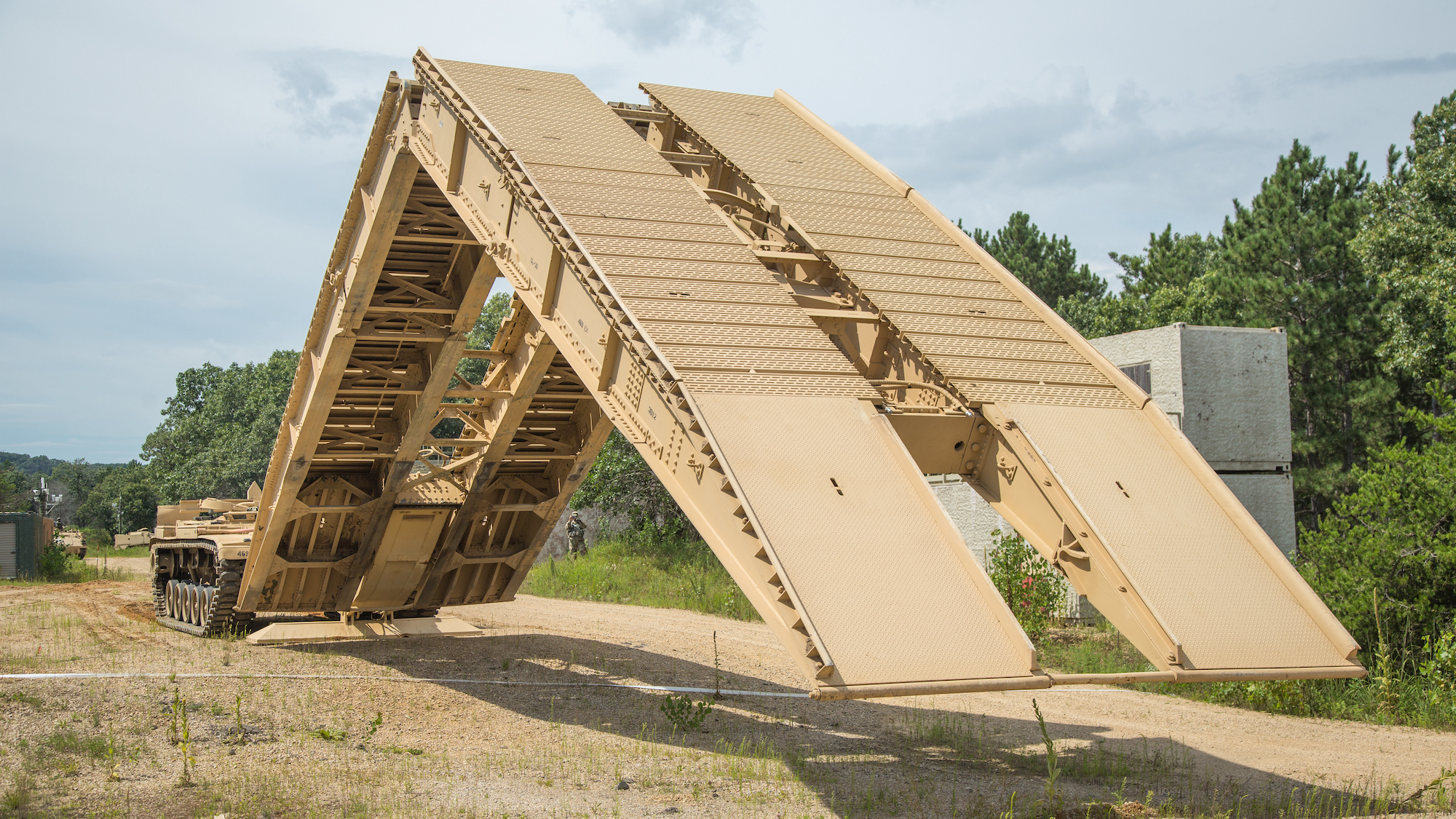

On March 3, the Department of Defense announced it would be sending mobile bridges to Ukraine. The bridges are the signature part of the Pentagon’s 33rd offering of existing US equipment to supply Ukraine, since Russia invaded the country in February 2022. These vehicles that can place bridges, along with the other equipment sent, are reflections of the shape of the war so far, and offer a glimpse into the tools the Biden Administration expects Ukraine to need in the coming spring thaw.
An Armored Vehicle Launched Bridge, or AVLB, is essentially a portable and durable structure that is carried, placed, and then removed by a modified tank hull. The specific Armored Vehicle Launched Bridges that will be sent to Ukraine are ones based on an M60 tank chassis, our colleagues at The War Zone report.
Rivers, chasms, and deep gaps in terrain can form impassable barriers to militaries, allowing defenders to concentrate forces at existing bridges or crossings. Getting over such a gap can necessitate flying to the other side, though that depends on an air transport force capable of massive movement and a cleared landing zone. It could mean physically building a new bridge, which can take time and is vulnerable to attack. Or it could mean bringing the bridge to the battlefield on the back of a tank and plopping it down as needed.
“These vehicles are designed to accompany armored columns and give them the ability to cross rivers, streams, ditches and trenches. The bridges are carried on the chassis of armored vehicles and launched at river or stream banks. Once the crossing is finished, the vehicle can pick up the bridge on the far bank and carry on,” the Department of Defense said in a release about this latest drawdown.
The exact number and model of the AVLBs sent to Ukraine is not yet known, though the general family is M60, or derived from the M60 Patton tank. That makes the models of a particular Cold War vintage, designed for the lighter armored vehicles and tanks of that era. Variants of the M60 AVLB have seen action in Vietnam, and have seen use in training exercises with NATO as well as in wars like Iraq.
The bridges are stored folded in half. When put in place by the vehicle, the bridges span 60 feet, can support up to 70 tons, and are 12.5 feet wide. Setting up the bridge takes between 2 and 5 minutes, and retrieving the bridge, which can be done at either end, takes about 10 minutes.
Some heavier vehicles, including modern combat tanks, can only use the bridge at slower speeds and over narrower gaps. The US Army and Marine Corps are working on a new bridge and launcher capable of supporting Bradley fighting vehicles and Abrams tanks, to better meet the needs of the US military.
Even with limitations, the bridges will expand how and where Ukrainian forces can operate and move. Being able to rapidly span a narrow but otherwise impassable river dramatically expands how and where an army can move and attack, creating room for surprise.
In addition, the announcement of the drawdown package notes that the US is sending Ukraine “demolition munitions and equipment for obstacle clearing,” which can facilitate both cleaner retreats and surprise advances. War leaves battlefields littered with craters, ruins, unexploded bombs, and deliberately set mines. Blasting a way through such hazards can restore movement to otherwise pinned forces.
Beyond the bridges and demolition equipment, the latest drawdown includes three kinds of artillery ammunition. The HIMARS rocket artillery systems, invaluable for Ukraine’s fall offensives, are getting resupplied with more rockets. The United States is also supplying Ukraine with 155mm and 105mm artillery rounds, for howitzers donated by the US and NATO allies to the country. These weapons use different ammunition than the Soviet-inherited stock that made up the bulk of Ukraine’s artillery before the war, and are still the overall majority of artillery pieces on hand today. But supplies for Soviet-pattern ammunition are scarce, as it’s also the size used by Russia, and Russia aggressively bought up existing stockpiles of the rounds around the world.
The fourth kind of ammunition included in the drawdown is 25mm, or the kind used by Bradley Infantry Fighting Vehicles. This tracked, turreted, and armed craft are more a form of fighting transport than a tanks, despite their appearance, but their 25 mm cannons are useful against all sorts of vehicles below the heavy armor of a tank. The package also includes tools for maintenance, vehicle testing and diagnostics, spare parts, and other of the less flashy but still invaluable work of ensuring vehicles can stay functional, or at least be repaired and brought back into use quickly.
Taken altogether, the latest drawdown of equipment fits the pattern of supplies to Ukraine this year. US supplies continue to give Ukraine the tools to fight existing artillery duels along grinding front lines, as well as building up the armored forces and accompanying features, like mobile bridges, needed for a future offensive.
